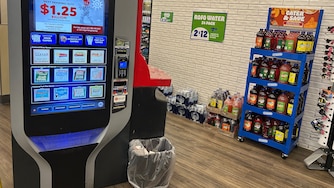Most people find riding a bike on busy, multilane streets or roads without shoulders intimidating, but for many rides across the Baltimore region — from Columbia to Fort Meade, or Towson into Baltimore, or up past White Marsh into Harford County, for example — at some point, there’s no other option.
Regional planners are identifying gaps where better infrastructure could make the Baltimore region more bikeable — and they want public feedback.
The Baltimore Metropolitan Council, a planning board that helps the state and local governments align their plans for federal funding, compiled existing and planned bike routes across Anne Arundel, Baltimore, Carroll, Harford, Howard and part of Queen Anne’s counties, as well as Baltimore City, into one big map. From there, they focused on gaps where no bike lanes exist and roadways designated for bikes that they consider potentially too “high stress” to be safe and useful.
The proposed Regional Bike Network doesn’t create or plan any new bike lanes on its own, said Charlene Mingus, a planner at the council overseeing the development of the network. But it aims to stitch together isolated plans by identifying possible connections between them, she said.
It has the potential to kick local lawmakers and their transportation staffs into gear to follow through on stagnant plans to build out more bike-friendly infrastructure — or it could become just another plan that lawmakers ignore. Though recent surveys show general regional support for building multi-use trails, bike lanes have become a kind of third rail, sparking heated public debate over how to allocate space on the road.
The Baltimore City Department of Transportation has been slow to build out its proposed network of separated bike lanes, a pace considered too slow for some and too rushed — haphazard, even — for others.
Baltimore County released its own bike master plan last year, but without allocating the money to act on it anytime soon. Howard County has been in on the action, too, and even got help from the state and a national nonprofit to install a temporary bike lane on a dangerous road to try to calm traffic.
But those plans often don’t work in tandem. Big possible connection points, like a proposal to link the NCR Trail in north central Baltimore County and the Jones Falls Trail in Baltimore, could help turn local clusters into a larger network.
Mingus hopes that pointing out the gaps between their plans can help local planners work together to close them, making their projects more competitive for larger federal grants.
The metropolitan council’s team conducted about 130 “handlebar interviews” with bike riders to get an on-the-ground sense of where bikers feel safe, where they don’t, and where they’d like to see improvements. They also talked with people who are hesitant to hop on a bike for one reason or another, but would like to. They interviewed both recreational riders and people who bike as a form of transportation.
“The big thing we heard from people is, ‘We just want a connected network so that we can get to these locations without having to drive or be able to get to them at all,’” Mingus said.
Gaps on the project Story Map show where bike lanes don’t exist and a county hasn’t planned for any. In Baltimore County, there are big gaps on the east side near Dundalk and along the U.S. 40 corridor near White Marsh. It notes multiple gaps in connecting with Baltimore City, including near Catonsville, Lutherville, Towson and perhaps most notably at the site of the fallen Francis Scott Key Bridge.
Anne Arundel’s biggest gap is across the Chesapeake Bay with western Queen Anne’s County. Howard County has gaps in Savage (connecting to Anne Arundel and Fort Meade), between Columbia and Ellicott City, and in its western reaches. Harford could connect Bel Air to plans along the Route 40 corridor.
Carroll County, meanwhile, has the biggest gaps with no connections to Baltimore or Howard counties.
The maps also include plenty of orange-highlighted “high stress” bikeways — roads merely marked with sharrows to show it should be shared or with bike lanes along busy roads — that planners suggest safer alternatives be developed for. Yellow-highlighted areas are considered “less comfortable” — planners are seeking more public feedback on these routes to determine if they should be considered high- or low-stress.
The public can take an online survey regarding the plan or share comments directly on the online bike map by Jan. 10. They also can offer feedback at an in-person public meeting Dec. 10 at Baltimore Unity Hall or a virtual meeting Dec. 12. Both are at 6 pm.
Mingus’ colleagues also are seeking input on transportation issues more broadly, as well as climate, housing and economic growth options in the region. The public can fill out the metropolitan council’s ‘What If?’ online survey, available here, regarding those issues now until Dec. 8.





Comments
Welcome to The Banner's subscriber-only commenting community. Please review our community guidelines.